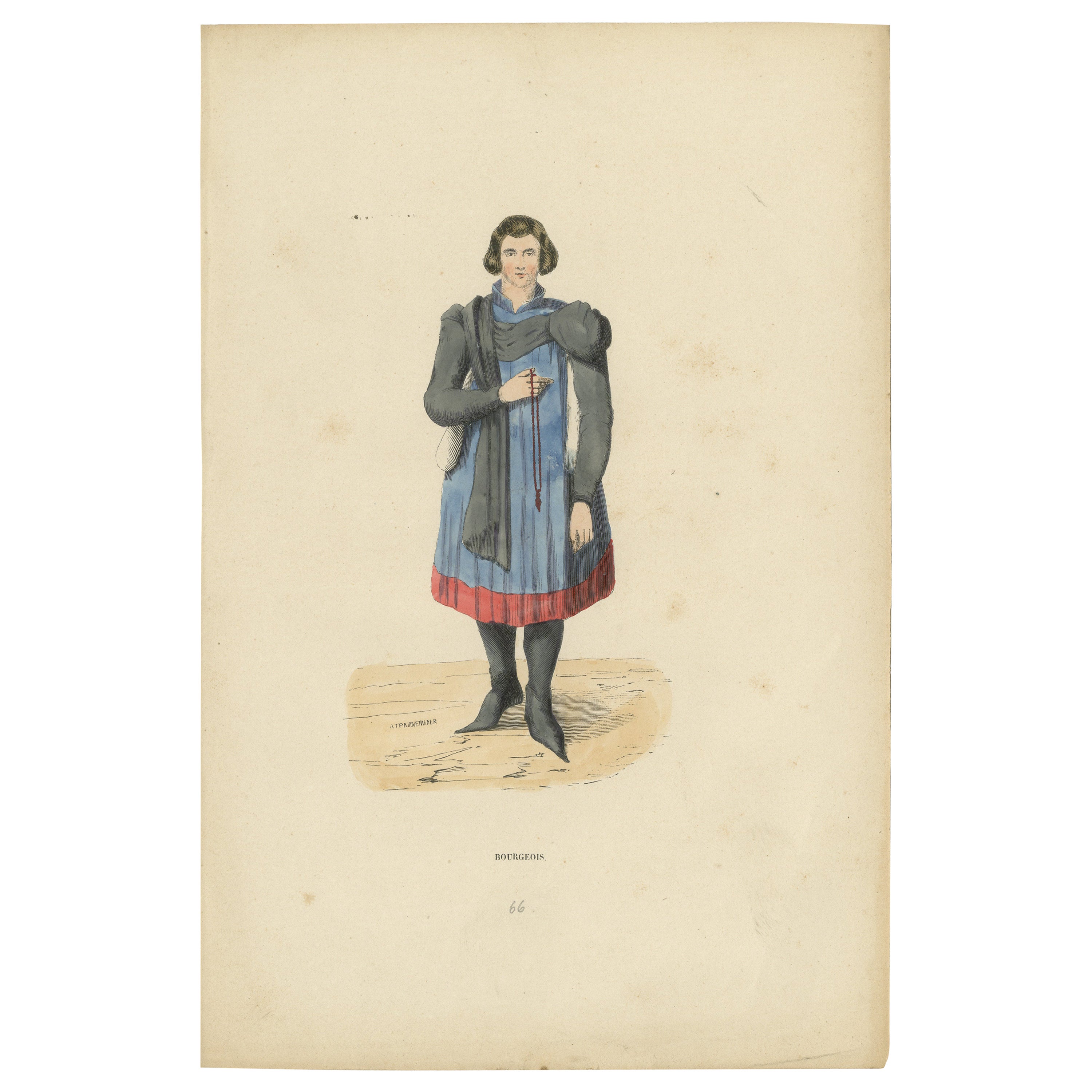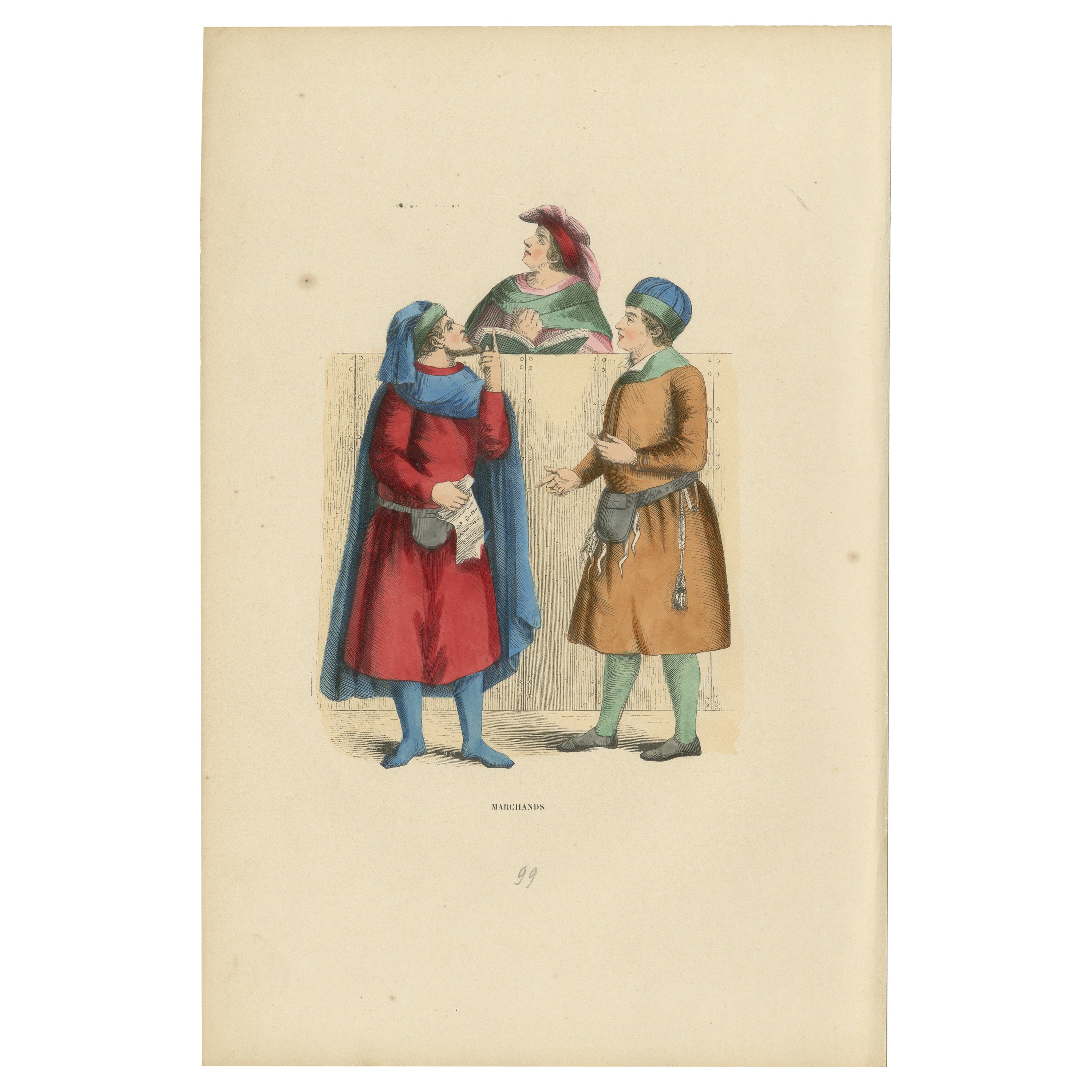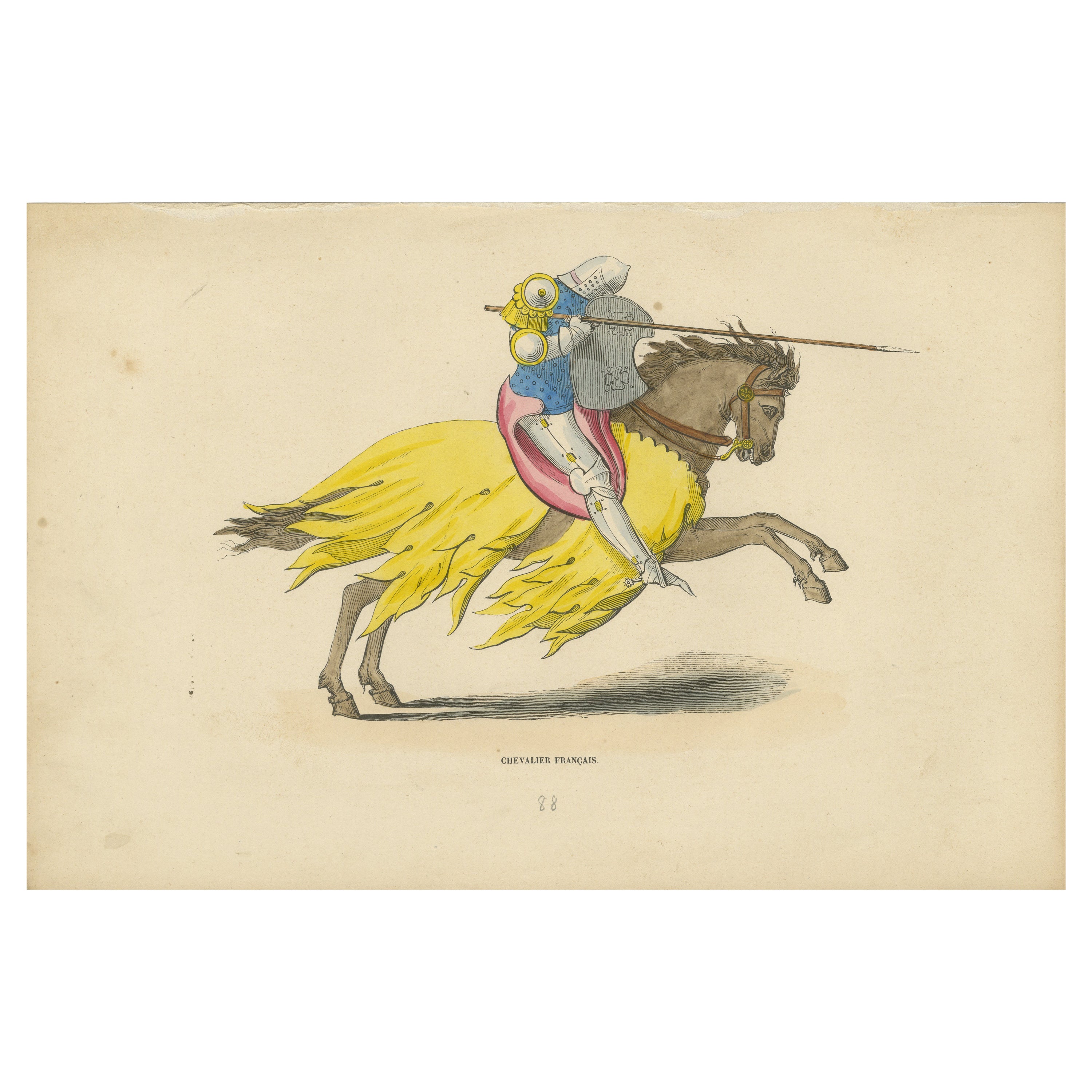Items Similar to Engraving of a Guardian of the Fort: The Medieval Arbaletrier, 1847
Want more images or videos?
Request additional images or videos from the seller
1 of 6
Engraving of a Guardian of the Fort: The Medieval Arbaletrier, 1847
About the Item
The image is labeled "Arbaletrier," which is French for crossbowman. It depicts a medieval soldier equipped for battle.
The crossbowman is dressed in a pink tunic with a blue collar, which stands out boldly against the simpler tunics often worn by soldiers of the time. His outfit is practical for combat, allowing for movement while providing some level of protection. He has a belt with a pouch and what appears to be a key, and he is carrying a crossbow, indicative of his role as an arbaletrier. His shoes are simple and functional, appropriate for marching or standing on uneven ground during battle.
His stance is confident, with the crossbow held in one hand and his weight shifted onto one leg, perhaps indicating readiness for action or a moment of rest. The presence of a castle or fortified town in the background suggests he may be standing guard or preparing for a siege.
The colors have a nice glow over them. Historically, egg whites, known as glair, and sometimes egg yolk were indeed used in illumination and painting, particularly in manuscripts, to give colors a brighter appearance and to add a sheen or gloss to the work. This technique was quite common during the Middle Ages and into the Renaissance.
Egg whites can be applied as a varnish over pigments to enhance their brightness and to protect the colors. This application could make the colors appear more vivid and also add a slight glossy sheen to the surface of the image.
Egg yolk, on the other hand, was commonly used as a binding agent in paint. It forms the basis of tempera paint, a medium that was widely used before the advent of oil painting. Egg yolk helps to create a durable and long-lasting color that adheres well to various surfaces.
In the context of the print from 1847, it's less likely that egg whites or yolks were used directly on the print, as by that time, commercial printing processes would have been more advanced and less reliant on such manual methods. However, if this print is a representation of an earlier style or is meant to mimic the appearance of hand-painted manuscripts, the original artists might have employed techniques or materials that gave a similar effect to those achieved with egg-based binders and varnishes.
- Dimensions:Height: 10.63 in (27 cm)Width: 7.09 in (18 cm)Depth: 0 in (0.02 mm)
- Materials and Techniques:
- Period:
- Date of Manufacture:1847
- Condition:Good. Overal very light toning and light soiling but the image itself clean and hand-colored almost 200 years ago and still in expliciet colors. Aged paper with typically warm, yellowish-brown hue, mostly around the edges. Study the image carefully.
- Seller Location:Langweer, NL
- Reference Number:
About the Seller
5.0
Platinum Seller
These expertly vetted sellers are 1stDibs' most experienced sellers and are rated highest by our customers.
Established in 2009
1stDibs seller since 2017
1,919 sales on 1stDibs
Typical response time: <1 hour
- ShippingRetrieving quote...Ships From: Langweer, Netherlands
- Return PolicyA return for this item may be initiated within 14 days of delivery.
More From This SellerView All
- Engraving of Medieval Bourgeois: A Portrait of Urban Sophistication, 1847Located in Langweer, NLTitle: "Medieval Bourgeois: A Portrait of Urban Sophistication" Description: This print appears to depict a man of the bourgeoisie, the urban middle class, during the medieval perio...Category
Antique 1840s Prints
MaterialsPaper
- Scholar of the Arts: The Medieval Academic, 1847Located in Langweer, NLTitle: "Scholar of the Arts: The Medieval Academic" Description: This print illustrates a learned individual, likely a doctor of the arts or a scholar, from the medieval period. The...Category
Antique 1840s Prints
MaterialsPaper
- Medieval French Merchants in Discourse, Original Antique Engraving of 1847Located in Langweer, NLTitle: "Medieval Merchants in Discourse" Description: This colorful print is titled "Marchands," which means "Merchants" in French, suggesting that it portrays a scene of merchants ...Category
Antique 1840s Prints
MaterialsPaper
- Charge of Valor: The Medieval French Knight, 1847Located in Langweer, NLTitle: "Charge of Valor: The Medieval French Knight" Description: This vibrant antique print captures the dynamic energy of a French knight in full gallop. ...Category
Antique 1840s Prints
MaterialsPaper
- Scholar of the Codex: A Medieval Jurist in Study, 1847Located in Langweer, NLThe image depicts a person labeled "Docteur des Lois," which translates to "Doctor of Laws." This term historically refers to an individual who has achieved advanced scholarly status in the field of law, equivalent to the modern term "Juris Doctor." The figure is seated at a lectern, deeply engrossed in a large book, which likely represents legal texts or scholarly works. The individual is attired in a robe with a fur-lined cape, suggesting a status of academic or professional distinction. The robe is red, a color often associated with higher education and learning. The headwear appears to be a type of turban, which was a common academic regalia in certain cultures and times. The setting and attire suggest that this person is a scholar or a high-ranking legal professional, possibly a university professor or a magistrate from the medieval or Renaissance period. Egg whites can be applied as a varnish over pigments to enhance their brightness and to protect the colors. This application could make the colors appear more vivid and also add a slight glossy sheen to the surface of the image. Egg yolk, on the other hand, was commonly used as a binding agent in paint. It forms the basis of tempera paint, a medium that was widely used before the advent of oil painting. Egg yolk helps to create a durable and long-lasting color that adheres well to various surfaces. In the context of the print from 1847, it's less likely that egg whites or yolks were used directly on the print, as by that time, commercial printing processes would have been more advanced and less reliant on such manual methods. However, if this print is a representation of an earlier style or is meant to mimic the appearance of hand-painted...Category
Antique 1840s Prints
MaterialsPaper
- Toil of the Ages: Medieval Peasantry at Work, 1847Located in Langweer, NLThe image depicts two medieval peasants, as indicated by the caption "Paysans," which is French for "Peasants". The figure on the left is wearing a simple tunic with leggings and a...Category
Antique 1840s Prints
MaterialsPaper
You May Also Like
- "Guardian of the Spire" Etching by John Taylor ArmsLocated in Toledo, OHThis etching by John Taylor Arms is titled "Guardians of the Spire." John Taylor Arms(1887-1953) was a famous printmaker in the early 20th century. This etching features two griffin ...Category
Vintage 1920s Gothic Revival Prints
MaterialsPaper
- French Engraving "The Monument"Located in Carmel, CA"The Monument" W H Toms, scup (engraver) Plate size; 13.75 X 8.25 Frame size: 23.5 X 18 The print is hand colored, and framed with museum grade mat and carved frame.Category
Antique 1790s Louis XVI Prints
- The First of September "Morning" Engraving, 1799Located in Carmel, CAMezzotint engraving, 1799, The First of September, after painting by George Moreland. Moreland was a noted London landscape and genre painter. By the...Category
Antique 1790s English Georgian Prints
MaterialsPaper
- German copperplate engraving of the nativity, 1600'sLocated in Kenilworth, ILCopperplate engraving of the nativity printed on hand laid paper. The piece has an incredible level of fine detail for the diminutive size of the work. ...Category
Antique 17th Century German Prints
MaterialsPaper
- Steel Engraving of the Portrait of Peter Paul RubensLocated in Saint-Ouen, FRSteel engraving of the portrait of Peter Paul Rubens, 19th century. Measures: H 27cm, L 20cm.Category
Antique 19th Century French Napoleon III Prints
MaterialsPaper
- “The Restaurant of the House of Representatives” Engraving by Harper's WeeklyLocated in Colorado Springs, COThis original wood engraving is titled “The Restaurant of the House of Representatives, Washington, DC.” It was published as a double-page image, in the August 12, 1893 issue of the famous 19th century newspaper Harper’s Weekly. The print was illustrated by Charles Stanley Reinhardt. The House Restaurant, a unique part of life in the Capitol, has been in the same location since the 1857 Capitol Expansion. Congressional members’ busy work schedule made the availability of food on site a necessity. But the restaurant also served as an informal meeting spot for members to continue conversations and deal making. This 1893 print illustrates the convivial atmosphere. Details including elegantly dressed tables...Category
Antique 1890s American Prints
MaterialsPaper





